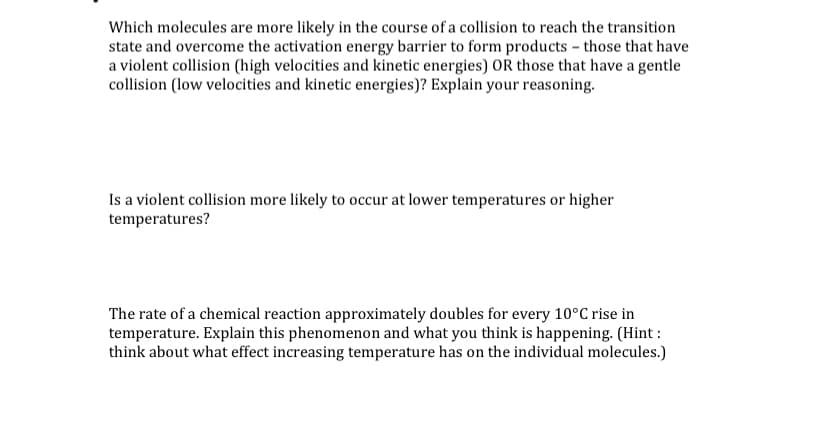Which molecules are more likely in the course of a collision to reach the transition state and overcome the activation energy barrier to form products - those that have a violent collision (high velocities and kinetic energies) OR those that have a gentle collision (low velocities and kinetic energies)? Explain your reasoning. Is a violent collision more likely to occur at lower temperatures or higher temperatures? The rate of a chemical reaction approximately doubles for every 10°C rise in temperature. Explain this phenomenon and what you think is happening. (Hint : think about what effect increasing temperature has on the individual molecules.)
Which molecules are more likely in the course of a collision to reach the transition state and overcome the activation energy barrier to form products - those that have a violent collision (high velocities and kinetic energies) OR those that have a gentle collision (low velocities and kinetic energies)? Explain your reasoning. Is a violent collision more likely to occur at lower temperatures or higher temperatures? The rate of a chemical reaction approximately doubles for every 10°C rise in temperature. Explain this phenomenon and what you think is happening. (Hint : think about what effect increasing temperature has on the individual molecules.)
Introductory Chemistry: A Foundation
9th Edition
ISBN:9781337399425
Author:Steven S. Zumdahl, Donald J. DeCoste
Publisher:Steven S. Zumdahl, Donald J. DeCoste
Chapter10: Energy
Section: Chapter Questions
Problem 59QAP
Related questions
Question

Transcribed Image Text:Consider the reaction
2 HCl → H2 +Cl2

Transcribed Image Text:Which molecules are more likely in the course of a collision to reach the transition
state and overcome the activation energy barrier to form products - those that have
a violent collision (high velocities and kinetic energies) OR those that have a gentle
collision (low velocities and kinetic energies)? Explain your reasoning.
Is a violent collision more likely to occur at lower temperatures or higher
temperatures?
The rate of a chemical reaction approximately doubles for every 10°C rise in
temperature. Explain this phenomenon and what you think is happening. (Hint :
think about what effect increasing temperature has on the individual molecules.)
Expert Solution
This question has been solved!
Explore an expertly crafted, step-by-step solution for a thorough understanding of key concepts.
Step by step
Solved in 4 steps

Knowledge Booster
Learn more about
Need a deep-dive on the concept behind this application? Look no further. Learn more about this topic, chemistry and related others by exploring similar questions and additional content below.Recommended textbooks for you

Introductory Chemistry: A Foundation
Chemistry
ISBN:
9781337399425
Author:
Steven S. Zumdahl, Donald J. DeCoste
Publisher:
Cengage Learning

Chemistry: Matter and Change
Chemistry
ISBN:
9780078746376
Author:
Dinah Zike, Laurel Dingrando, Nicholas Hainen, Cheryl Wistrom
Publisher:
Glencoe/McGraw-Hill School Pub Co

Chemistry by OpenStax (2015-05-04)
Chemistry
ISBN:
9781938168390
Author:
Klaus Theopold, Richard H Langley, Paul Flowers, William R. Robinson, Mark Blaser
Publisher:
OpenStax

Introductory Chemistry: A Foundation
Chemistry
ISBN:
9781337399425
Author:
Steven S. Zumdahl, Donald J. DeCoste
Publisher:
Cengage Learning

Chemistry: Matter and Change
Chemistry
ISBN:
9780078746376
Author:
Dinah Zike, Laurel Dingrando, Nicholas Hainen, Cheryl Wistrom
Publisher:
Glencoe/McGraw-Hill School Pub Co

Chemistry by OpenStax (2015-05-04)
Chemistry
ISBN:
9781938168390
Author:
Klaus Theopold, Richard H Langley, Paul Flowers, William R. Robinson, Mark Blaser
Publisher:
OpenStax

World of Chemistry, 3rd edition
Chemistry
ISBN:
9781133109655
Author:
Steven S. Zumdahl, Susan L. Zumdahl, Donald J. DeCoste
Publisher:
Brooks / Cole / Cengage Learning

Chemistry: The Molecular Science
Chemistry
ISBN:
9781285199047
Author:
John W. Moore, Conrad L. Stanitski
Publisher:
Cengage Learning

Chemistry: Principles and Practice
Chemistry
ISBN:
9780534420123
Author:
Daniel L. Reger, Scott R. Goode, David W. Ball, Edward Mercer
Publisher:
Cengage Learning